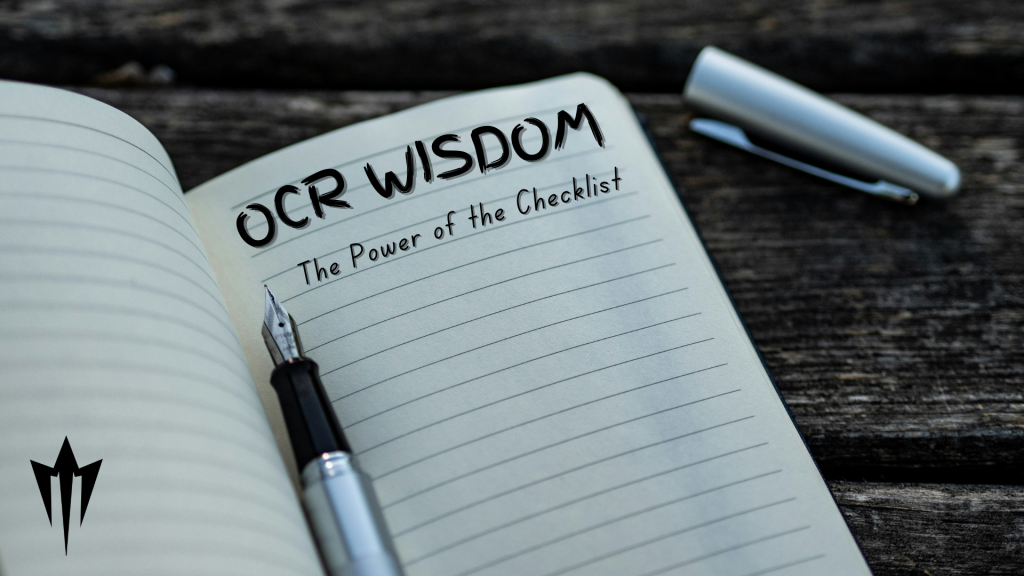We often chase the next big productivity hack—new apps, time-blocking systems, or color-coded calendars. But sometimes, the most powerful tools are also the simplest.
Enter: the humble checklist.
If you’re like Joshua, running a business, managing a team, balancing fitness, personal goals, and family life—it can feel like your brain has 37 tabs open at all times. But one practice that’s never failed him—whether he’s organizing a new OCR Academy program, planning an expansion, or just structuring his own day—is writing things down. Specifically, creating a checklist.
Why Checklists Work
In his bestselling book The Checklist Manifesto: How to Get Things Right, surgeon and author Atul Gawande shows how even the most complex professions—from operating rooms to airplane cockpits—rely on checklists to reduce errors and improve outcomes.
His core message? The volume and complexity of knowledge today exceed our individual ability to deliver it consistently, correctly, and safely. Checklists bridge that gap.
When you build a good checklist, you’re not just writing reminders. You’re creating a system for consistent execution. And that, in any area of life, is the key to getting things right.
What a Checklist Did for Josh
Here’s a real example. When we launched HYROX classes at OCR Academy, it wasn’t just about putting the equipment in place and scheduling a class time. There were dozens of moving parts: instructor certification, marketing, social posts, scheduling software updates, signage, onboarding new members, and more. It would’ve been easy to miss something critical. But a detailed launch checklist kept us on track—and helped us hit the ground running without dropping the ball.
Even day-to-day? Josh uses a handwritten checklist each morning with three categories: must-do, should-do, and could-do. That mental clarity lets him stay focused, especially on days that go sideways (and let’s face it—some do).
The Science Behind the Simplicity
Why do checklists work so well?
1. They reduce cognitive load. You stop relying on memory and free your brain for deeper thinking.
2. They provide clarity. You know exactly what needs to get done and what can wait.
3. They build momentum. Each checked box gives a small hit of dopamine, fueling progress.
4. They promote accountability. Especially when shared with a team, checklists create transparency.
Build Your Checklist System
Here’s how to get started:
• Pick your format. Paper, whiteboard, phone app—whatever works for you. A good old notebook is always great for a daily list, and we use shared Google Sheets for team projects.
• Keep it short. Gawande says a checklist should be a cognitive net, not a comprehensive how-to manual. Aim for brevity and clarity.
• Categorize tasks. Use themes like Admin, Outreach, Fitness Programming, or Urgent / Important / Later.
• Review and update daily. A stale checklist becomes background noise. Make it a habit.
Try This: The OCR Checklist Challenge
Want to boost your own productivity? Here’s your call to action:
1. Create a checklist tonight for what you want to accomplish tomorrow. Keep it simple—3 to 5 items max.
2. Post it where you’ll see it, or better yet, write it out by hand.
3. At the end of the day, check your progress. Notice how you feel. Lighter? Clearer? More accomplished?
Repeat that for a week. You’ll start to see how much more intentional your days feel.
Final Thoughts
You don’t need to be a surgeon or pilot to benefit from the power of a checklist. Whether you’re training for your next HYROX, growing your business, or trying to find time to be present with your family—this simple habit will keep you grounded, focused, and moving forward.
Don’t underestimate it. In a world that’s always demanding more, a checklist helps you focus on what truly matters.



